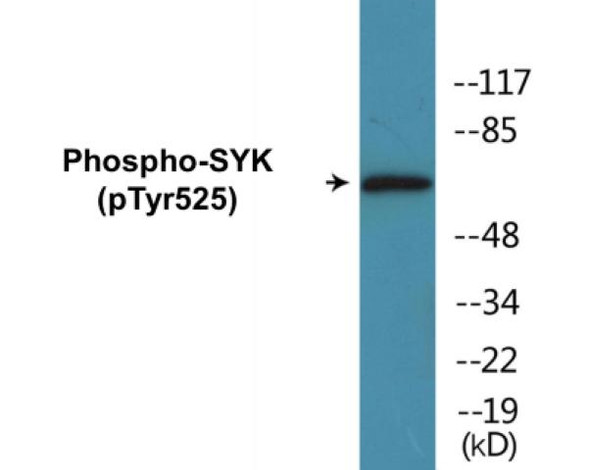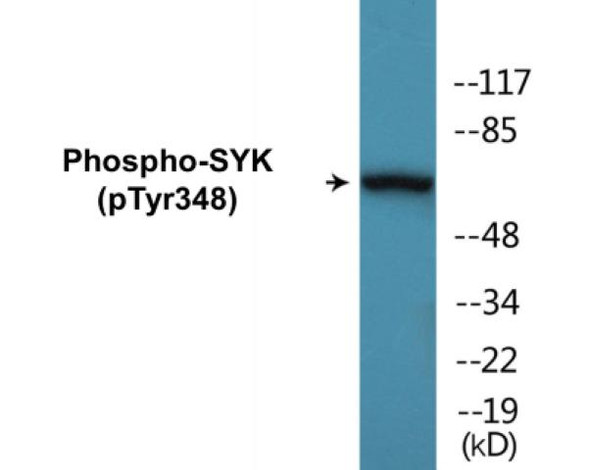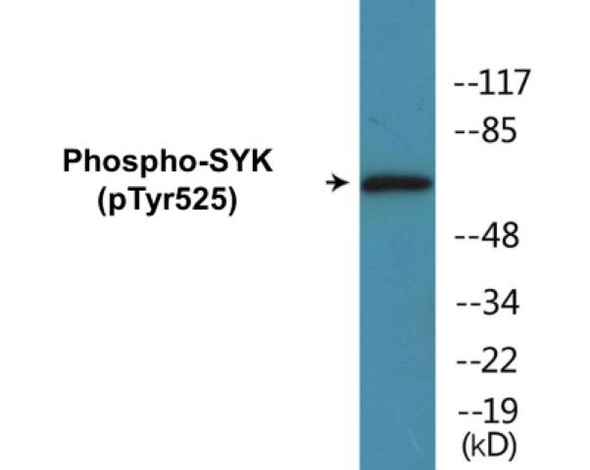Description
SYK Colorimetric Cell-Based ELISA Kit
The SYK Colorimetric Cell-Based ELISA Kit is specifically developed to accurately measure the activity of the spleen tyrosine kinase (SYK) in cell lysates and tissue homogenates. This kit provides high sensitivity and specificity, ensuring precise and reliable results for a variety of research applications.SYK is a critical protein involved in signal transduction pathways, regulating immune response and inflammatory processes.
Dysregulation of SYK has been linked to autoimmune diseases, allergies, and cancer, making it a valuable biomarker for studying these conditions and developing targeted therapies.With easy-to-follow protocols and quick assay turnaround times, the SYK Colorimetric Cell-Based ELISA Kit is the perfect tool for researchers seeking to evaluate SYK activity in their experimental samples with high precision and efficiency.
| Product Name: | SYK Colorimetric Cell-Based ELISA Kit |
| Product Code: | CBCAB00877 |
| ELISA Type: | Cell-Based |
| Target: | SYK |
| Reactivity: | Human |
| Dynamic Range: | > 5000 Cells |
| Detection Method: | Colorimetric 450 nmStorage/Stability:4°C/6 Months |
| Format: | 96-Well Microplate |
The SYK Colorimetric Cell-Based ELISA Kit is a convenient, lysate-free, high throughput and sensitive assay kit that can detect SYK protein expression profile in cells. The kit can be used for measuring the relative amounts of SYK in cultured cells as well as screening for the effects that various treatments, inhibitors (ie siRNA or chemicals), or activators have on SYK.
Qualitative determination of SYK concentration is achieved by an indirect ELISA format. In essence, SYK is captured by SYK-specific primary antibodies while the HRP-conjugated secondary antibodies bind the Fc region of the primary antibody. Through this binding, the HRP enzyme conjugated to the secondary antibody can catalyze a colorimetric reaction upon substrate addition. Due to the qualitative nature of the Cell-Based ELISA, multiple normalization methods are needed:
| 1. | A monoclonal antibody specific for human GAPDH is included to serve as an internal positive control in normalizing the target absorbance values. |
| 2. | Following the colorimetric measurement of HRP activity via substrate addition, the Crystal Violet whole-cell staining method may be used to determine cell density. After staining, the results can be analysed by normalizing the absorbance values to cell amounts, by which the plating difference can be adjusted. |
| Database Information: | Gene ID: 6850, UniProt ID: P43405, OMIM: 600085, Unigene: Hs.371720 |
| Gene Symbol: | SYK |
| Sub Type: | None |
| UniProt Protein Function: | Syk: a cytoplasmic tyrosine kinase of the SYK family containing two SH2 domains. Plays a central role in the B cell receptor (BCR) response. An upstream activator of the PI3K, PLCgamma2, and Rac/cdc42 pathways in the BCR response. Required for the sequential events of Fc gamma IIa receptor-mediated phagocytosis. Expression highest in murine spleen, heart, mammary gland and thymus. Two splice variant isoforms have been described. |
| UniProt Protein Details: | Protein type:EC 2.7.10.2; Protein kinase, tyrosine (non-receptor); Kinase, protein; Protein kinase, TK; TK group; Syk family Chromosomal Location of Human Ortholog: 9q22 Cellular Component: T cell receptor complex; extrinsic to internal side of plasma membrane; protein complex; cytoplasm; plasma membrane; nucleus; cytosol; B cell receptor complex Molecular Function:integrin binding; protein serine/threonine kinase activity; protein binding; protein-tyrosine kinase activity; non-membrane spanning protein tyrosine kinase activity; receptor signaling protein tyrosine kinase activity; protein kinase binding; ATP binding; protein kinase activity Biological Process: viral reproduction; transcription factor import into nucleus; positive regulation of interleukin-3 biosynthetic process; positive regulation of granulocyte macrophage colony-stimulating factor biosynthetic process; positive regulation of calcium-mediated signaling; regulation of phagocytosis; protein amino acid phosphorylation; activation of JNK activity; leukocyte adhesion; B cell receptor signaling pathway; regulation of transcription factor activity; positive regulation of bone resorption; beta selection; positive regulation of gamma-delta T cell differentiation; angiogenesis; inflammatory response; integrin-mediated signaling pathway; platelet activation; neutrophil chemotaxis; adaptive immune response; regulation of superoxide release; positive regulation of cell adhesion mediated by integrin; positive regulation of mast cell degranulation; regulation of neutrophil degranulation; leukotriene biosynthetic process; cell proliferation; positive regulation of peptidyl-tyrosine phosphorylation; organ morphogenesis; neutrophil activation during immune response; serotonin secretion by platelet; leukocyte activation during immune response; defense response to bacterium; macrophage activation during immune response; positive regulation of B cell differentiation; blood vessel morphogenesis; innate immune response; positive regulation of alpha-beta T cell proliferation; lymph vessel development; blood coagulation; transmembrane receptor protein tyrosine kinase signaling pathway; positive regulation of alpha-beta T cell differentiation; positive regulation of cytokine secretion |
| NCBI Summary: | This gene encodes a member of the family of non-receptor type Tyr protein kinases. This protein is widely expressed in hematopoietic cells and is involved in coupling activated immunoreceptors to downstream signaling events that mediate diverse cellular responses, including proliferation, differentiation, and phagocytosis. It is thought to be a modulator of epithelial cell growth and a potential tumour suppressor in human breast carcinomas. Alternatively spliced transcript variants encoding different isoforms have been found for this gene. [provided by RefSeq, Mar 2010] |
| UniProt Code: | P43405 |
| NCBI GenInfo Identifier: | 1174527 |
| NCBI Gene ID: | 6850 |
| NCBI Accession: | P43405.1 |
| UniProt Related Accession: | P43405 |
| Molecular Weight: | 635 |
| NCBI Full Name: | Tyrosine-protein kinase SYK |
| NCBI Synonym Full Names: | spleen tyrosine kinase |
| NCBI Official Symbol: | SYK |
| NCBI Official Synonym Symbols: | p72-Syk |
| NCBI Protein Information: | tyrosine-protein kinase SYK |
| UniProt Protein Name: | Tyrosine-protein kinase SYK |
| UniProt Synonym Protein Names: | Spleen tyrosine kinase; p72-Syk |
| Protein Family: | Tyrosine-protein kinase |
| UniProt Gene Name: | SYK |
| UniProt Entry Name: | KSYK_HUMAN |
| Component | Quantity |
| 96-Well Cell Culture Clear-Bottom Microplate | 2 plates |
| 10X TBS | 24 mL |
| Quenching Buffer | 24 mL |
| Blocking Buffer | 50 mL |
| 15X Wash Buffer | 50 mL |
| Primary Antibody Diluent | 12 mL |
| 100x Anti-Phospho Target Antibody | 60 µL |
| 100x Anti-Target Antibody | 60 µL |
| Anti-GAPDH Antibody | 60 µL |
| HRP-Conjugated Anti-Rabbit IgG Antibody | 12 mL |
| HRP-Conjugated Anti-Mouse IgG Antibody | 12 mL |
| SDS Solution | 12 mL |
| Stop Solution | 24 mL |
| Ready-to-Use Substrate | 12 mL |
| Crystal Violet Solution | 12 mL |
| Adhesive Plate Seals | 2 seals |
The following materials and/or equipment are NOT provided in this kit but are necessary to successfully conduct the experiment:
- Microplate reader able to measure absorbance at 450 nm and/or 595 nm for Crystal Violet Cell Staining (Optional)
- Micropipettes with capability of measuring volumes ranging from 1 µL to 1 ml
- 37% formaldehyde (Sigma Cat# F-8775) or formaldehyde from other sources
- Squirt bottle, manifold dispenser, multichannel pipette reservoir or automated microplate washer
- Graph paper or computer software capable of generating or displaying logarithmic functions
- Absorbent papers or vacuum aspirator
- Test tubes or microfuge tubes capable of storing ≥1 ml
- Poly-L-Lysine (Sigma Cat# P4832 for suspension cells)
- Orbital shaker (optional)
- Deionized or sterile water
*Note: Protocols are specific to each batch/lot. For the correct instructions please follow the protocol included in your kit.
| Step | Procedure |
| 1. | Seed 200 µL of 20,000 adherent cells in culture medium in each well of a 96-well plate. The plates included in the kit are sterile and treated for cell culture. For suspension cells and loosely attached cells, coat the plates with 100 µL of 10 µg/ml Poly-L-Lysine (not included) to each well of a 96-well plate for 30 minutes at 37°C prior to adding cells. |
| 2. | Incubate the cells for overnight at 37°C, 5% CO2. |
| 3. | Treat the cells as desired. |
| 4. | Remove the cell culture medium and rinse with 200 µL of 1x TBS, twice. |
| 5. | Fix the cells by incubating with 100 µL of Fixing Solution for 20 minutes at room temperature. The 4% formaldehyde is used for adherent cells and 8% formaldehyde is used for suspension cells and loosely attached cells. |
| 6. | Remove the Fixing Solution and wash the plate 3 times with 200 µL 1x Wash Buffer for five minutes each time with gentle shaking on the orbital shaker. The plate can be stored at 4°C for a week. |
| 7. | Add 100 µL of Quenching Buffer and incubate for 20 minutes at room temperature. |
| 8. | Wash the plate 3 times with 1x Wash Buffer for 5 minutes each time. |
| 9. | Add 200 µL of Blocking Buffer and incubate for 1 hour at room temperature. |
| 10. | Wash 3 times with 200 µL of 1x Wash Buffer for 5 minutes each time. |
| 11. | Add 50 µL of 1x primary antibodies (Anti-SYK Antibody and/or Anti-GAPDH Antibody) to the corresponding wells, cover with Parafilm and incubate for 16 hours (overnight) at 4°C. If the target expression is known to be high, incubate for 2 hours at room temperature. |
| 12. | Wash 3 times with 200 µL of 1x Wash Buffer for 5 minutes each time. |
| 13. | Add 50 µL of 1x secondary antibodies (HRP-Conjugated AntiRabbit IgG Antibody or HRP-Conjugated Anti-Mouse IgG Antibody) to corresponding wells and incubate for 1.5 hours at room temperature. |
| 14. | Wash 3 times with 200 µL of 1x Wash Buffer for 5 minutes each time. |
| 15. | Add 50 µL of Ready-to-Use Substrate to each well and incubate for 30 minutes at room temperature in the dark. |
| 16. | Add 50 µL of Stop Solution to each well and read OD at 450 nm immediately using the microplate reader. |
(Additional Crystal Violet staining may be performed if desired – details of this may be found in the kit technical manual.)






